radiator AUDI S4 1998 B5 / 1.G Engine Manual
[x] Cancel search | Manufacturer: AUDI, Model Year: 1998, Model line: S4, Model: AUDI S4 1998 B5 / 1.GPages: 72, PDF Size: 3.25 MB
Page 9 of 72
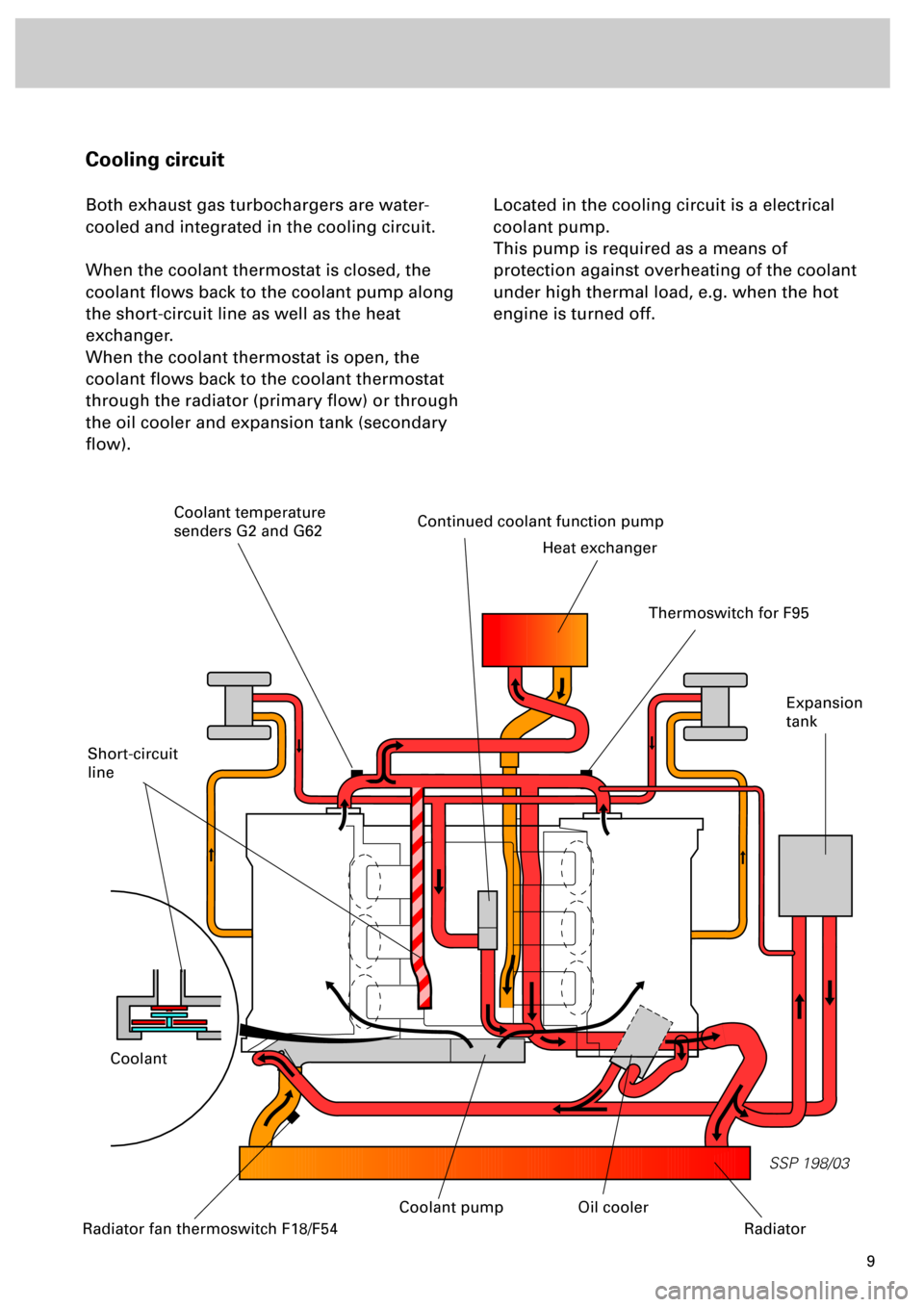
9
SSP 198/03
Cooling circuit
Both exhaust gas turbochargers are water-
cooled and integrated in the cooling circuit.
When the coolant thermostat is closed, the
coolant flows back to the coolant pump along
the short-circuit line as well as the heat
exchanger.
When the coolant thermostat is open, the
coolant flows back to the coolant thermostat
through the radiator (primary flow) or through
the oil cooler and expansion tank (secondary
flow).Located in the cooling circuit is a electrical
coolant pump.
This pump is required as a means of
protection against overheating of the coolant
under high thermal load, e.g. when the hot
engine is turned off.
Short-circuit
line
Continued coolant function pump
Heat exchanger
Coolant
Expansion
tank
Radiator fan thermoswitch F18/F54
Oil cooler
Radiator
Thermoswitch for F95
Coolant temperature
senders G2 and G62
Coolant pump
Page 10 of 72
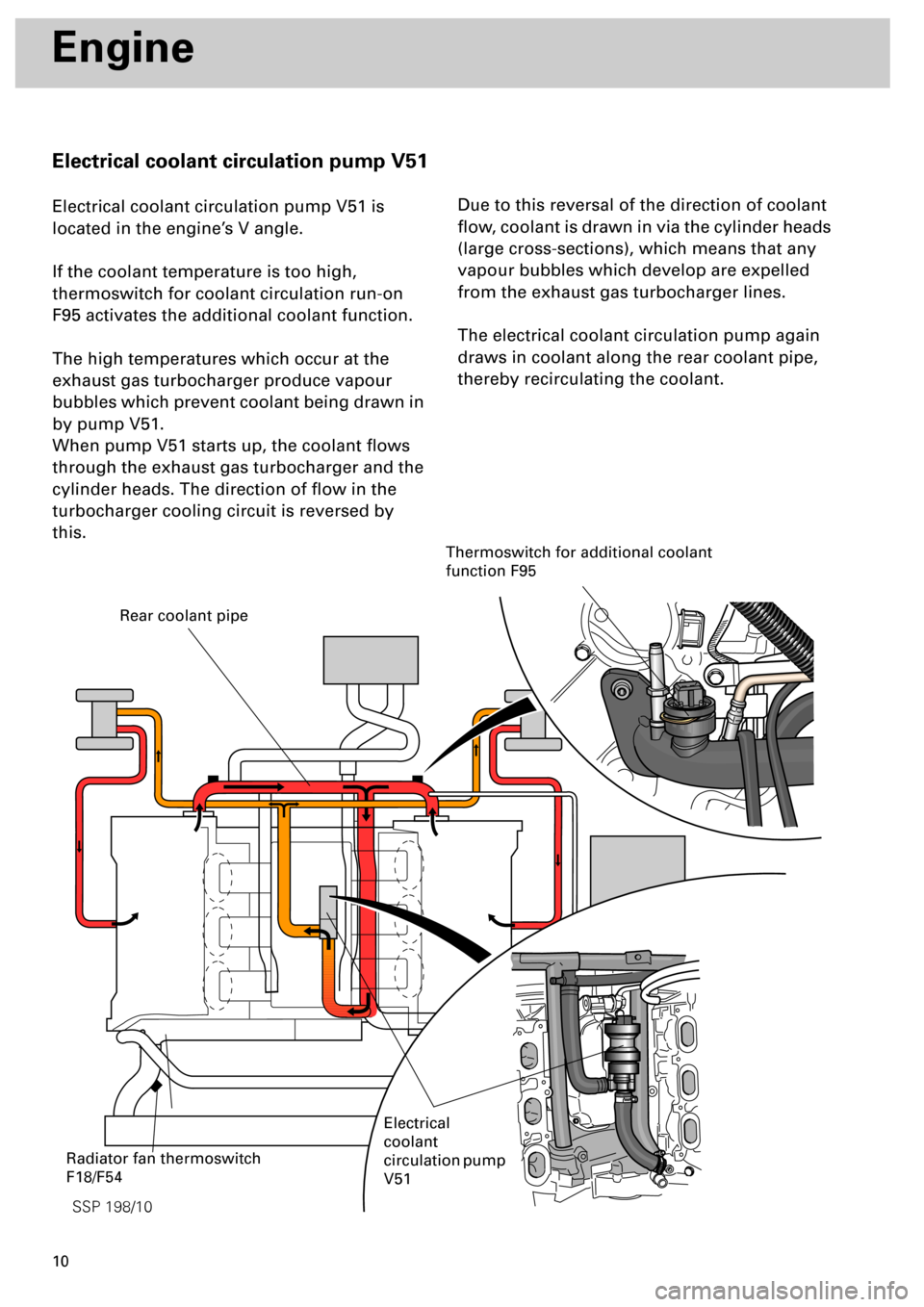
10
SSP 198/10
Engine
Electrical coolant circulation pump V51
Electrical coolant circulation pump V51 is
located in the engine’s V angle.
If the coolant temperature is too high,
thermoswitch for coolant circulation run-on
F95 activates the additional coolant function.
The high temperatures which occur at the
exhaust gas turbocharger produce vapour
bubbles which prevent coolant being drawn in
by pump V51.
When pump V51 starts up, the coolant flows
through the exhaust gas turbocharger and the
cylinder heads. The direction of flow in the
turbocharger cooling circuit is reversed by
this.Due to this reversal of the direction of coolant
flow, coolant is drawn in via the cylinder heads
(large cross-sections), which means that any
vapour bubbles which develop are expelled
from the exhaust gas turbocharger lines.
The electrical coolant circulation pump again
draws in coolant along the rear coolant pipe,
thereby recirculating the coolant.
Rear coolant pipe
Electrical
coolant
circulation pump
V51
Thermoswitch for additional coolant
function F95
Radiator fan thermoswitch
F18/F54
Page 11 of 72
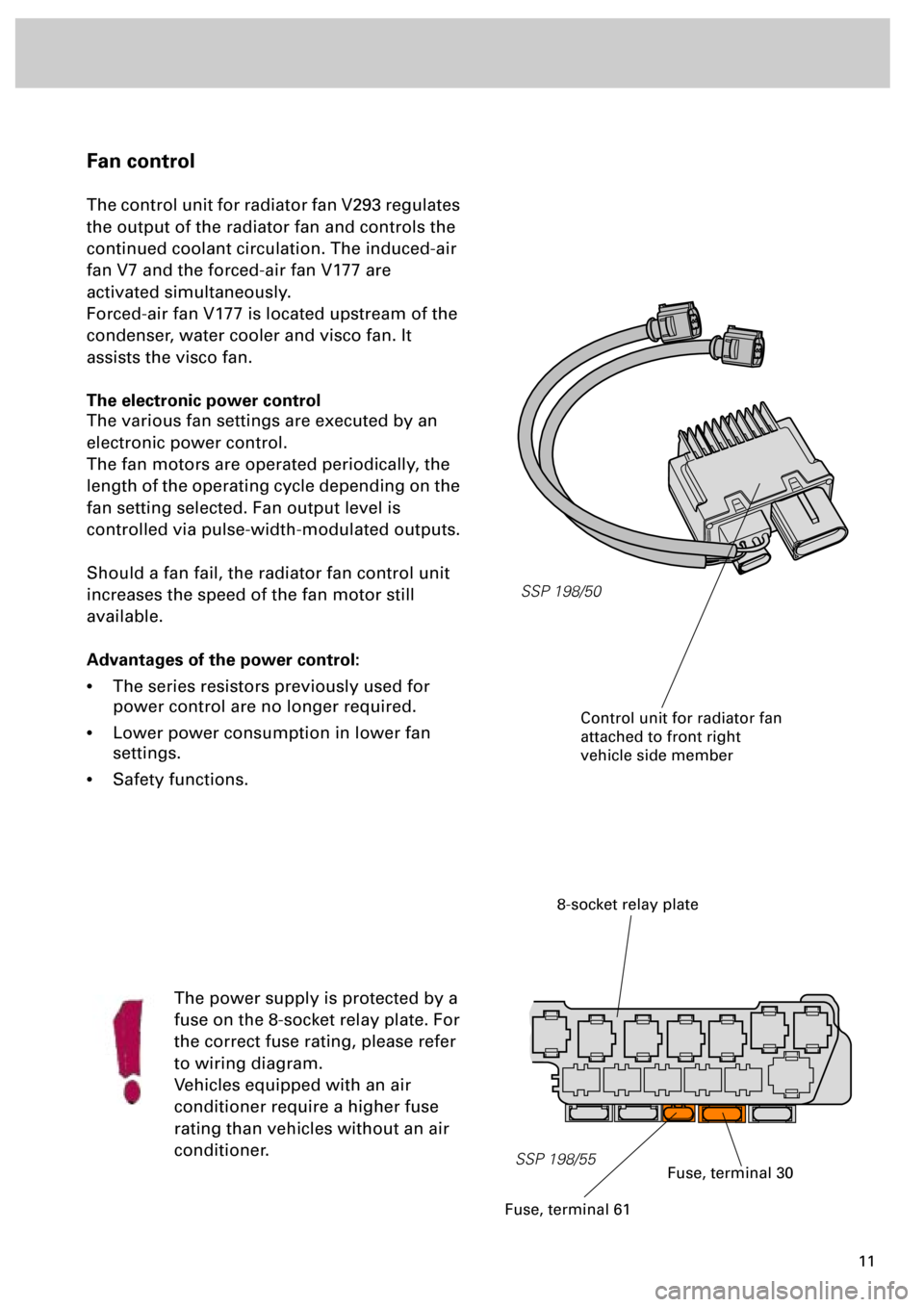
11
Fan control
The control unit for radiator fan V293 regulates
the output of the radiator fan and controls the
continued coolant circulation. The induced-air
fan V7 and the forced-air fan V177 are
activated simultaneously.
Forced-air fan V177 is located upstream of the
condenser, water cooler and visco fan. It
assists the visco fan.
The electronic power control
The various fan settings are executed by an
electronic power control.
The fan motors are operated periodically, the
length of the operating cycle depending on the
fan setting selected. Fan output level is
controlled via pulse-width-modulated outputs.
Should a fan fail, the radiator fan control unit
increases the speed of the fan motor still
available.
Advantages of the power control:
•
The series resistors previously used for
power control are no longer required.
•
Lower power consumption in lower fan
settings.
•
Safety functions.
The power supply is protected by a
fuse on the 8-socket relay plate. For
the correct fuse rating, please refer
to wiring diagram.
Vehicles equipped with an air
conditioner require a higher fuse
rating than vehicles without an air
conditioner.
SSP 198/50
8-socket relay plate
SSP 198/55
Control unit for radiator fan
attached to front right
vehicle side member
Fuse, terminal 30
Fuse, terminal 61
Page 12 of 72
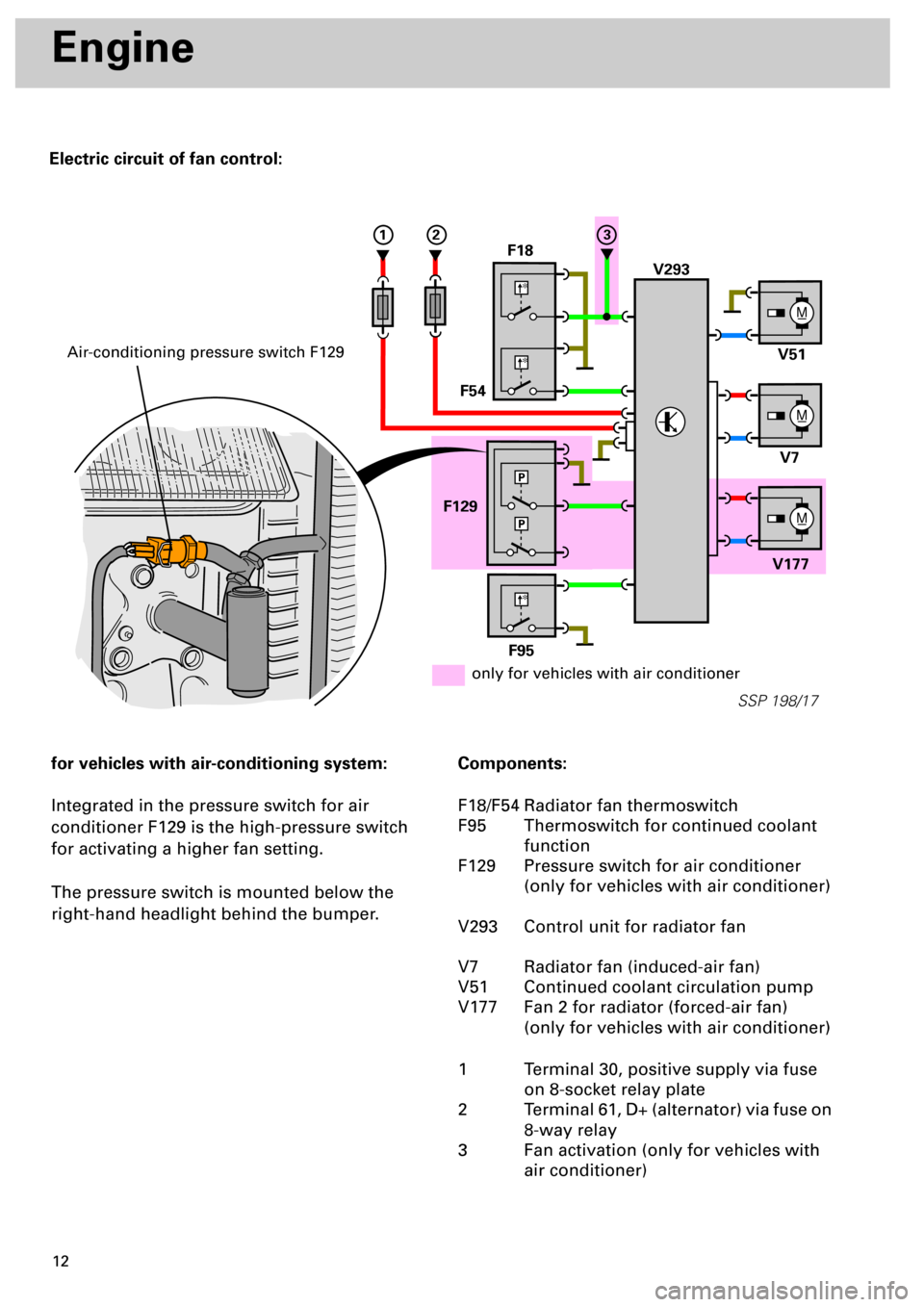
12
Electric circuit of fan control:
Engine
for vehicles with air-conditioning system:
Integrated in the pressure switch for air
conditioner F129 is the high-pressure switch
for activating a higher fan setting.
The pressure switch is mounted below the
right-hand headlight behind the bumper.
Components:
F18/F54 Radiator fan thermoswitch
F95 Thermoswitch for continued coolant
function
F129 Pressure switch for air conditioner
(only for vehicles with air conditioner)
V293 Control unit for radiator fan
V7 Radiator fan (induced-air fan)
V51 Continued coolant circulation pump
V177 Fan 2 for radiator (forced-air fan)
(only for vehicles with air conditioner)
1 Terminal 30, positive supply via fuse
on 8-socket relay plate
2 Terminal 61, D+ (alternator) via fuse on
8-way relay
3 Fan activation (only for vehicles with
air conditioner)
M_
V293 F18
F54
F129
V177V7 V51
M_
M_
SSP 198/17
*
*
F95
*
P
P
123
only for vehicles with air conditioner
Air-conditioning pressure switch F129
Page 13 of 72
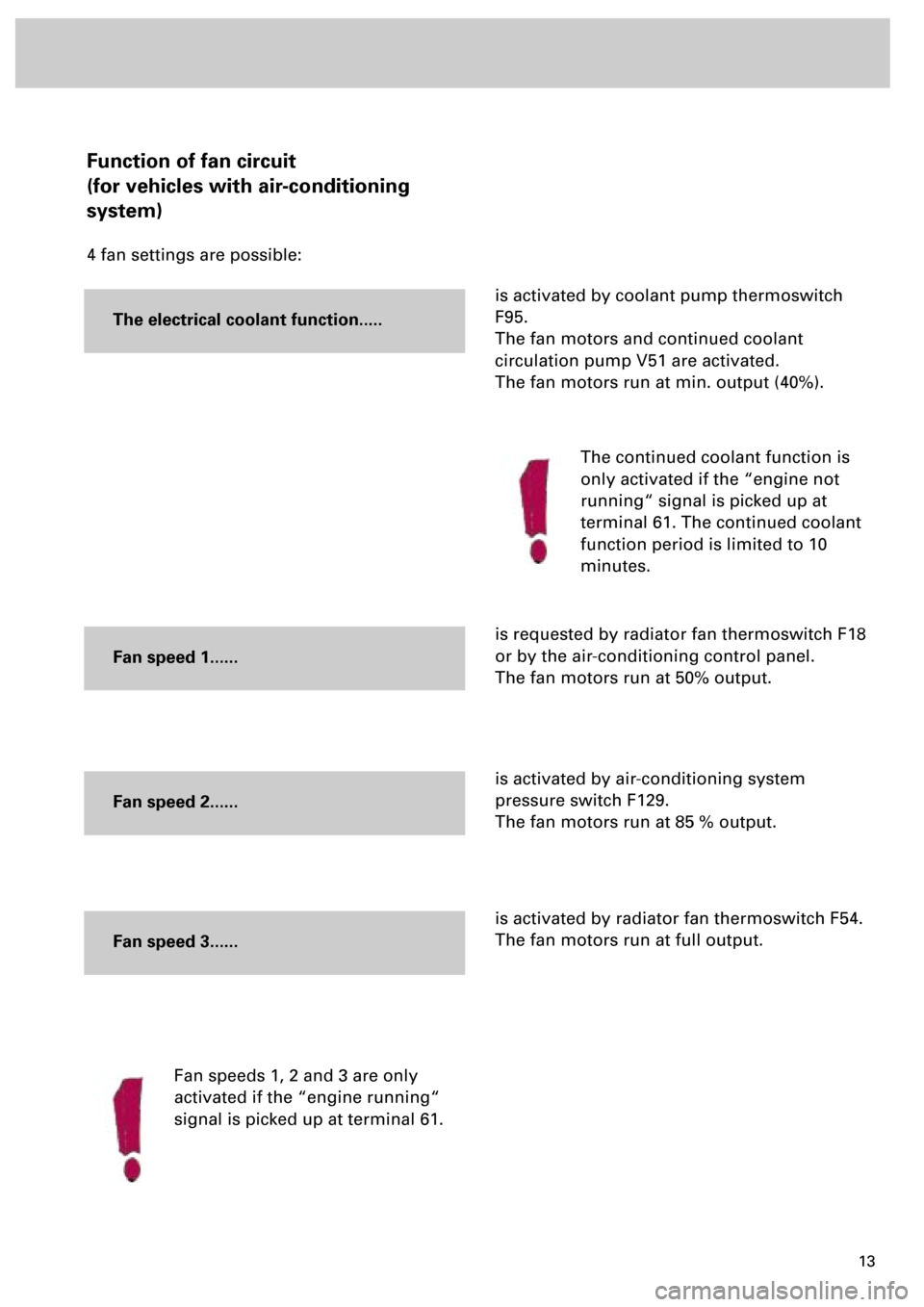
13
Function of fan circuit
(for vehicles with air-conditioning
system)
4 fan settings are possible:
is activated by coolant pump thermoswitch
F95.
The fan motors and continued coolant
circulation pump V51 are activated.
The fan motors run at min. output (40%).
is requested by radiator fan thermoswitch F18
or by the air-conditioning control panel.
The fan motors run at 50% output.
is activated by air-conditioning system
pressure switch F129.
The fan motors run at 85 % output.
is activated by radiator fan thermoswitch F54.
The fan motors run at full output.
Fan speeds 1, 2 and 3 are only
activated if the “engine running“
signal is picked up at terminal 61.
The electrical coolant function.....
The continued coolant function is
only activated if the “engine not
running“ signal is picked up at
terminal 61. The continued coolant
function period is limited to 10
minutes.
Fan speed 1......
Fan speed 2......
Fan speed 3......